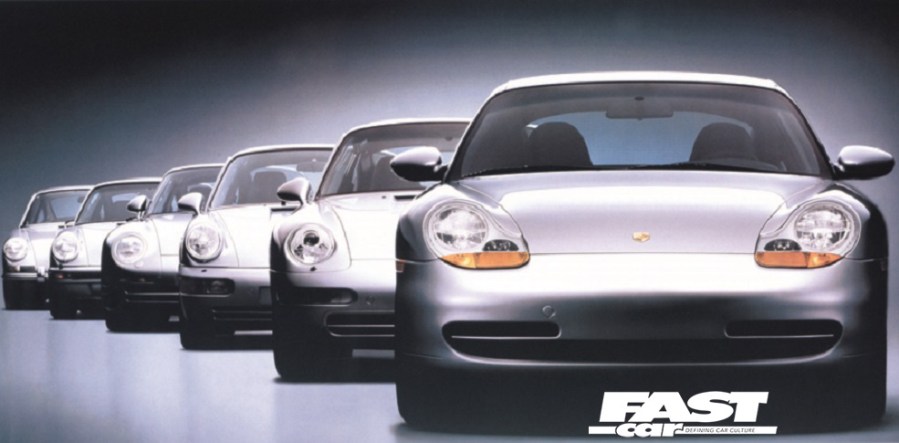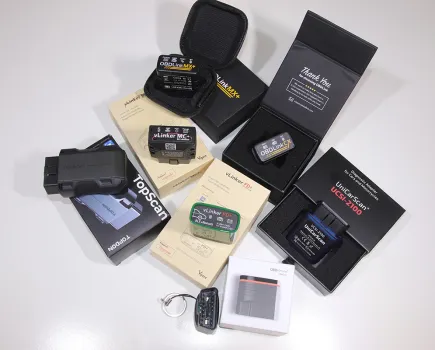It’s time to learn your 930s from your 997s as we debunk the Porsche 911 model timeline from the 1960s up to the noughties.
At the 1963 Frankfurt motor show, Porsche revealed the 356 successor, which was named the 901. Wait, 901? A small problem arose when Peugeot mentioned its trademarked moniker with an “0” in the middle, so Porsche had to get creative. The answer was simple, they’d already designed a 9 and a 1 for badging, so just stick another 1 in place of the 0 to create 911. Genius.

Porsche 911: 1963-1973
These early cars, appropriately named 911 and 911S (more powerful version of the regular car) are now referred to as classic 911s, which introduced the iconic Fuchs alloys and of course the Targa top. This also saw the arrival of the famous 911R, which in 1967 used lightened glazing, thin glassfibre panels and a Mezger-designed 901/22 2.0-litre engine out of the 906 Carrera 6 race car. This saw its peak power jump to 206bhp, over the 128bhp found in the entry-level 911T.

The development of the early 911s continued through the 70s, with displacement growing to 2.2-litres, then to 2.4-litres in 1971. The Carrera RS 2.7 arrived in 1972 and featured a newly-developed 911/83 2687cc flat-six. Built initially for competition by Norbert Singer, performance was rated at 206bhp.

Porsche 911 G Series: 1974-1989
It was time to simplify the range. The E and T models were given the boot, while a base 911, 911S and Carrera were then produced. The Carrera entered life as the European top-of-the-line model, with 206bhp. This remained until the 930 Turbo took over in 1975. Note the 930 nomenclature, which relates to the engine code – 930/50, a 3.0-litre turbocharged flat-six with 265bhp. You’ll often see models in this era referred to 930, and this relates only to the Turbo models, the Carrera, for example, would be known only as a G-series car.
From 1978, Carreras were powered by a new version of the 2994cc engine that was present in previous cars. The focus was to improve mid-range torque and to also fine tune the engine to allow for lower-octane fuels in the North American market. However, this lifted power to 247bhp, which was too close to the top-of-the-range Turbo, which in 1978 also received a refresh, getting the newer 930/60 motor that upped power to 296bhp.

This model is regarded as the last truly original-bodied 911s and as such carry some premium over other models. There are also a handful of special editions to mention, from the 911 Speedster to the Slant Nose 930S Turbo all of which culminated in Porsche’s next project, the 959.

Porsche 959: The fastest car in the world
Built initially for Group B racing, the 959 never saw a race track in its life. By the time it was ready, Group B was banned, making its only success in motorsport being a Paris Dakar Rally in 1986. But the 959 was so much more than a race car; its real-world application of world-leading technology has lifted it to a pedestal few have reached.
Although being based on the 911 and taking bits from the 928 such as aluminium doors and hood, the rest of the body was a marvel of modern tech, utilising Kevlar-reinforced Fiberglass and deformable polyurethane. It rightly earned the title of the most technically advanced supercar built to date, with an electronically-controlled four-wheel drive system, adjustable dampers and an ABS system, much of which would later be found in the Cayenne SUV that debuted in 2002/03.
Further advancements were made with the engine; an aluminium flat-six with an air-cooled block was employed, producing 450bhp. The four-valve-per-cylinder heads were water-cooled by twin radiators, one behind each rear wheel. Engine management was provided by Bosch, and twin KKK turbos acted sequentially so that boost was available throughout the rev range.

Porsche 911 964: 1989-1994
Following the triumph of the 959, Porsche realised that all the technology it had worked so hard on in the 959 could be filtered into mainstream 911 models, thus creating the new 964 derivative of the 911. According to Porsche, 85% of the car was new from the previous 3.2-litre Carrera. Included in that was a new engine, M64/01; this came in 3600cc guise and produced 247bhp in base form, the same as the previous 3.2 Carrera.
The new model was designed to captivate drivers, not only with performance but also with enhanced comfort. It came with ABS, optional Tiptronic automatic transmission, power steering and airbags, and rode on a completely redesigned chassis with coils by light alloy control arms instead of the previous torsion-bar suspension.

A revolutionary member of the new 911 line came right from the start: the all-wheel drive Carrera 4 model. The rear-wheel-drive Carrera 2 came on the market six months later. In addition to the Carrera Coupe, Cabriolet and Targa versions, starting in 1990 customers could also order the 964 Turbo. Initially powered by the proven 3.3-litre flat engine, in 1992 the Turbo was upgraded to include a more powerful 360bhp 3.6-litre power unit. Alongside that performance, the Turbo came with a wide bodykit, featuring huge rear hips and a redesigned whale tail spoiler that was wide enough to land a Boeing.
The most revered 964 came in RS form, though, which combined the Carrera’s narrow body with the M64/04 3.7-litre naturally-aspirated flat-six and a stripped out interior for increased lightness.

Porsche 911 993: 1994-1998
The 993 was the first 911 with an aluminium chassis. A sleek body that belied its increased agility was made possible with integrated bumpers, a switch from round to polyellipsoidal headlights; this allowed the front nose to be lower-slung than on other models.
The whole body on the 911 was curved and smooth. It hadn’t grown in size, which was crucial, but underneath things were fairly similar. The Carrera engine, for example, was only lightly fettled with, producing no more power.

The Turbo model, however, gained all-wheel drive from the Carrera 4, helping to tame the near 400bhp performance. Midway through its lifecycle the Turbo gained a more powerful S version, which featured an M64/60S twin-turbo 3.6-litre flat-six with an eye-watering 444bhp and carbon ceramic brakes, the first for a 911.
Competition was responsible for the jump in power, but subsequent models were made outside of homologation for endurance racing. While the GT2 model, a rear-drive, wide-bodied model made the headlines in 424bhp in standard trim, and 592bhp in EVO trim, it was the unique GT1 that stands out. It featured the same engine used in the 959, but this time in a GT1 Class-style body.

Porsche 911 996: 1998-2005
Marking a big change for the 911, the 966 was now water-cooled. Thanks to its four-valve 3.4-litre six it achieved 300 hp and broke new ground in terms of reduced emissions, noise, and fuel consumption.
The exterior design was a reinterpretation of the 911’s classic lines, but with a lower drag coefficient of 0.30. The lines of the 996 were also a result of joint development with Porsche’s successful Boxster model. Its most obvious exterior feature were the headlights with integrated direction indicators.

On the inside, there was an entirely new cockpit, with much improved comfort and ergonomics. There were Carrera 4, 4S and Turbo models, while more extreme models were also lined up. First was the 3.6-litre GT3, then the GT2 that combined the Turbo’s engine and body with the track-focused GT3 elements, also featuring ceramic brakes as standard.
Porsche 911 continues
What was called the 997 followed on from the 996, being an evolutionary step that simply refined the recipe while styling was subdued and more closely matched 911s of old. There were Carrera, Carrera 4, a return of the Carrera S model, Turbo and GT models to name a few.
This has continued to be the marketing approach for the timeless Porsche sports car, with the 991 and 992 (current model) representing the manufacturer’s latest engineering achievements.




